Nerve cells, also called neurons, are cells that make up the nervous system. The main function of nerve cells is to receive, process, and transmit information.
These cells receive signals from different sensory organs or other neurons, process this information, and then transmit signals to target cells, such as other neurons, muscles, or other organs. This communication is important for different body functions including controlling movement and supporting cognitive processes like memory and learning. So, nerve cells act as messengers that transmit information from external stimuli to the brain which processes the information and generates responses to the stimuli.
Interesting Science Videos
Types of Nerve Cells
Nerve cells are classified into three main types based on their function.
- Sensory neurons are nerve cells that detect and transmit signals from the external environment to the central nervous system (CNS). These cells gather information from specialized tissues in various parts of the body known as sensory receptors. When a sensory neuron detects a signal from the receptor, it converts this information into electrical impulses, which are then transmitted to the CNS. Sensory neurons are also called afferent neurons. They detect a wide range of stimuli, including touch, taste, smell, and pain.
- Motor neurons are nerve cells that transmit signals from the CNS to muscles. These neurons initiate and control voluntary and involuntary muscle movements. Motor neurons are also called efferent neurons. These nerve cells are divided into upper and lower motor neurons. Upper motor neurons transmit signals to interneurons and lower motor neurons while lower motor neurons receive signals from upper motor neurons or interneurons and convert these signals into actual muscle movements.
- Interneurons are the most abundant type of nerve cells and are only found in the central nervous system. These cells act as connectors between sensory and motor nerve cells. They receive signals from other interneurons or sensory neurons and transmit them to motor neurons or other interneurons.
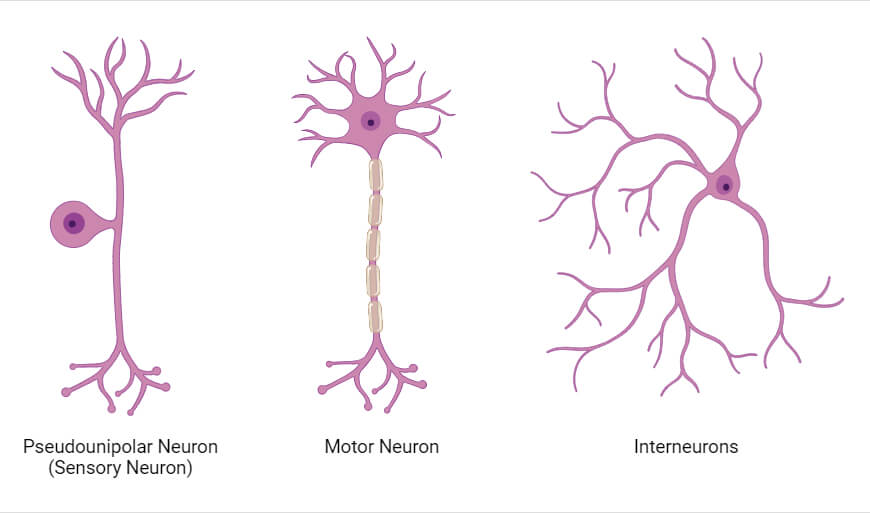
Nerve cells can also be classified into four types based on their structure.
- Unipolar neurons have a single structure extending from the cell body which contains one axon with dendrites. They are commonly found in invertebrates.
- Bipolar neurons have two structures – one axon and one dendrite, extending from the cell body.
- Multipolar neurons contain one axon and multiple symmetrical dendrites extending from the cell body. This is the most common type of neuron.
- Pseudounipolar neurons have only one process that extends from the cell body, which separates into two structures. These nerve cells do not have dendrites.
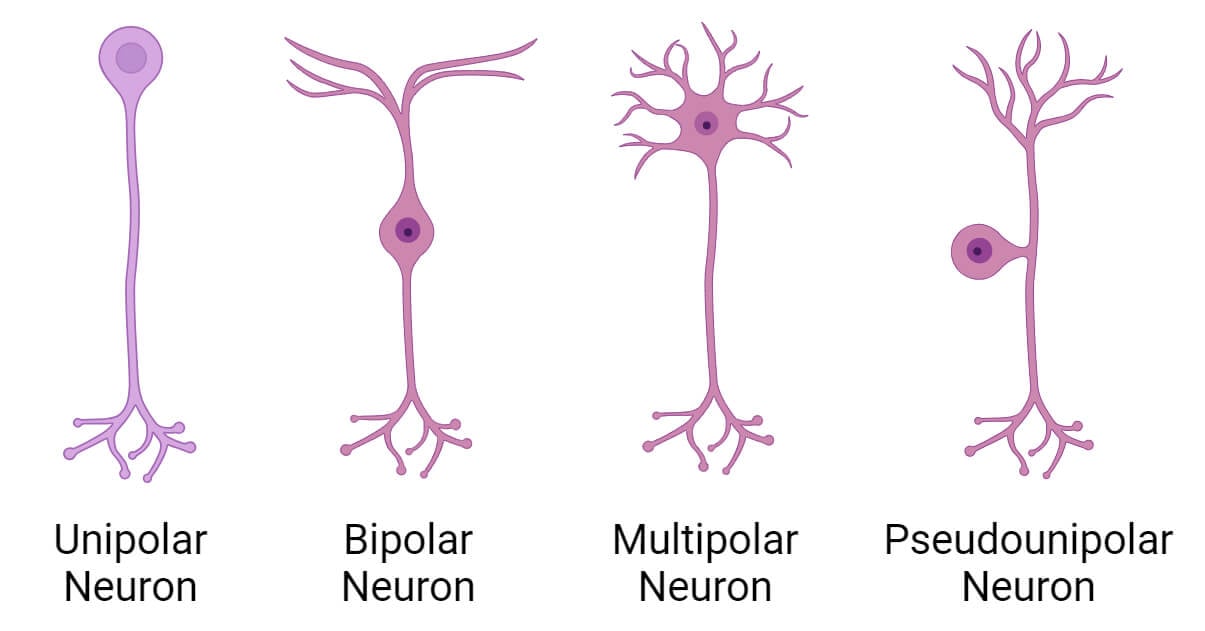
Anatomy and Structure of Nerve Cells
A nerve cell contains three main parts: cell body, dendrites, and axon.
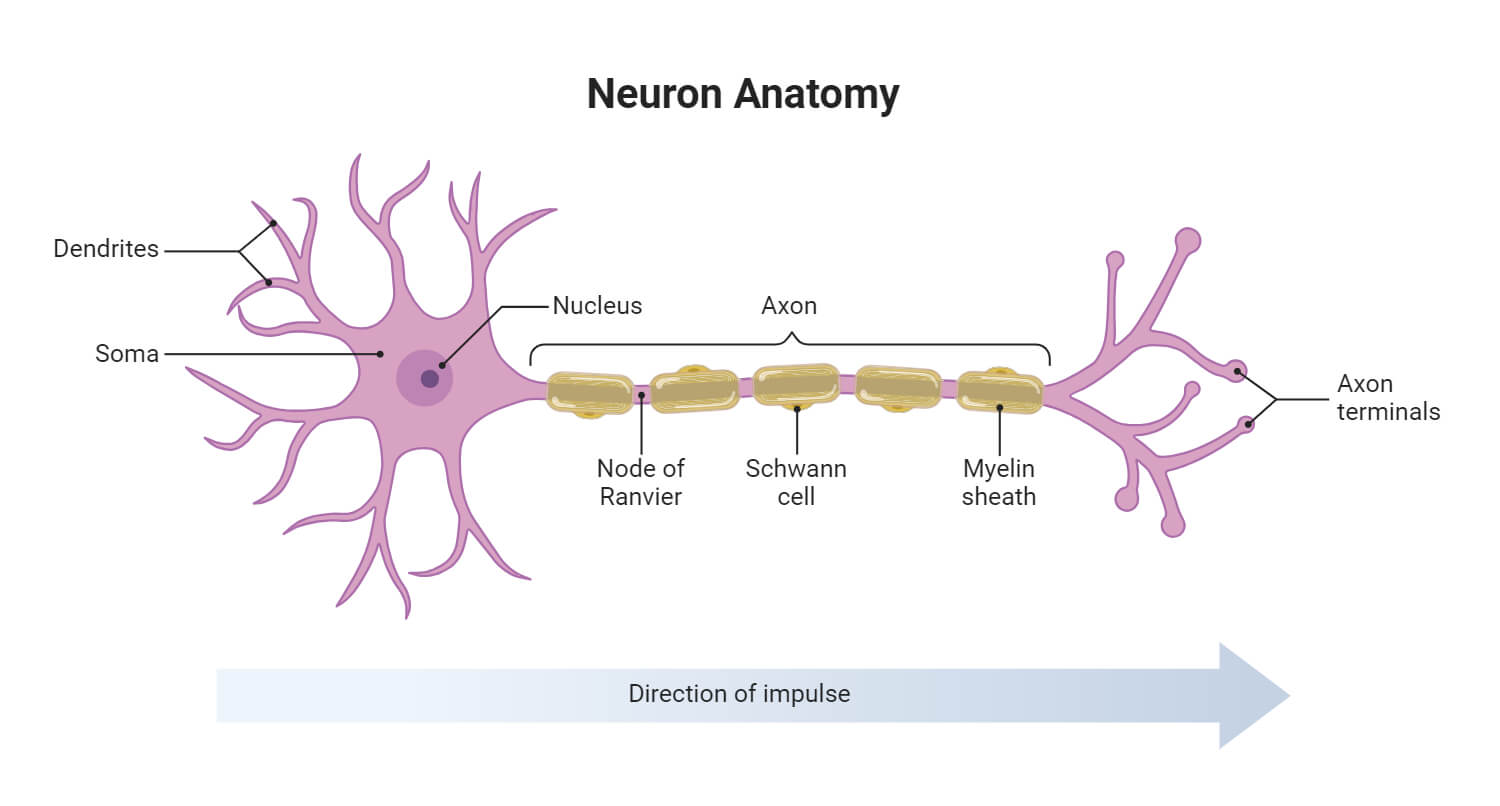
- The cell body, also known as the soma, is the central part of the nerve cell which contains the nucleus of the cell and various cell organelles like the endoplasmic reticulum, Golgi apparatus, mitochondria, and lysosomes. These organelles produce proteins and generate energy within the cell. The cell body gives rise to dendrites and axons. It maintains the nerve cell and is involved in the growth and development of the nerve cell.
- Dendrites are structures like tree branches extending from the cell body. They receive signals from other neurons acting as receptors and convert them into electrical impulses. Their branching structure is useful for receiving signals from other neurons. Dendrites are mainly made up of dendritic shafts and tiny extensions known as dendritic spines which contain neurotransmitter receptors on their membranes.
- Axon is another extension of the cell body that carries signals away from the cell body. It is connected to the cell body at a point called the axon hillock. The primary function of the axon is to transmit electrical signals to other neurons, muscles, or glands. Axons can be covered by a protective layer of fatty material called myelin sheath that speeds up the transmission of nerve impulses. The axon terminal, located at the end of the axon, is the point where information is transmitted to target cells.
Nerve Impulses and Action Potential
- Nerve impulses are the signals transmitted through the nervous system which allows communication between cells. Nerve impulses from one neuron are passed onto another through sites called synapses.
- Before a nerve impulse is transmitted through a synapse, an action potential must be generated in the presynaptic neuron. The action potential refers to a rapid change in the membrane potential.
- Initially, neurons have a resting membrane potential that maintains a negative charge inside the cell with a higher concentration of sodium ions outside and potassium ions inside the cells. This is maintained by the sodium-potassium pump.
- When a nerve cell receives a stimulus from other neurons, sodium channels on the cell membrane open. This allows sodium ions to flow into the cell, causing depolarization. The membrane potential changes to positive.
- After depolarization, the membrane potential begins the process of repolarization. Potassium channels open and allow potassium ions to leave the cell, restoring the original resting membrane potential.
- The action potential reaches the end of the axon and triggers the release of chemical messengers called neurotransmitters into the synapse. Neurotransmitters bind to receptors on the postsynaptic neuron. In this way, the signal is passed on to the next neuron.
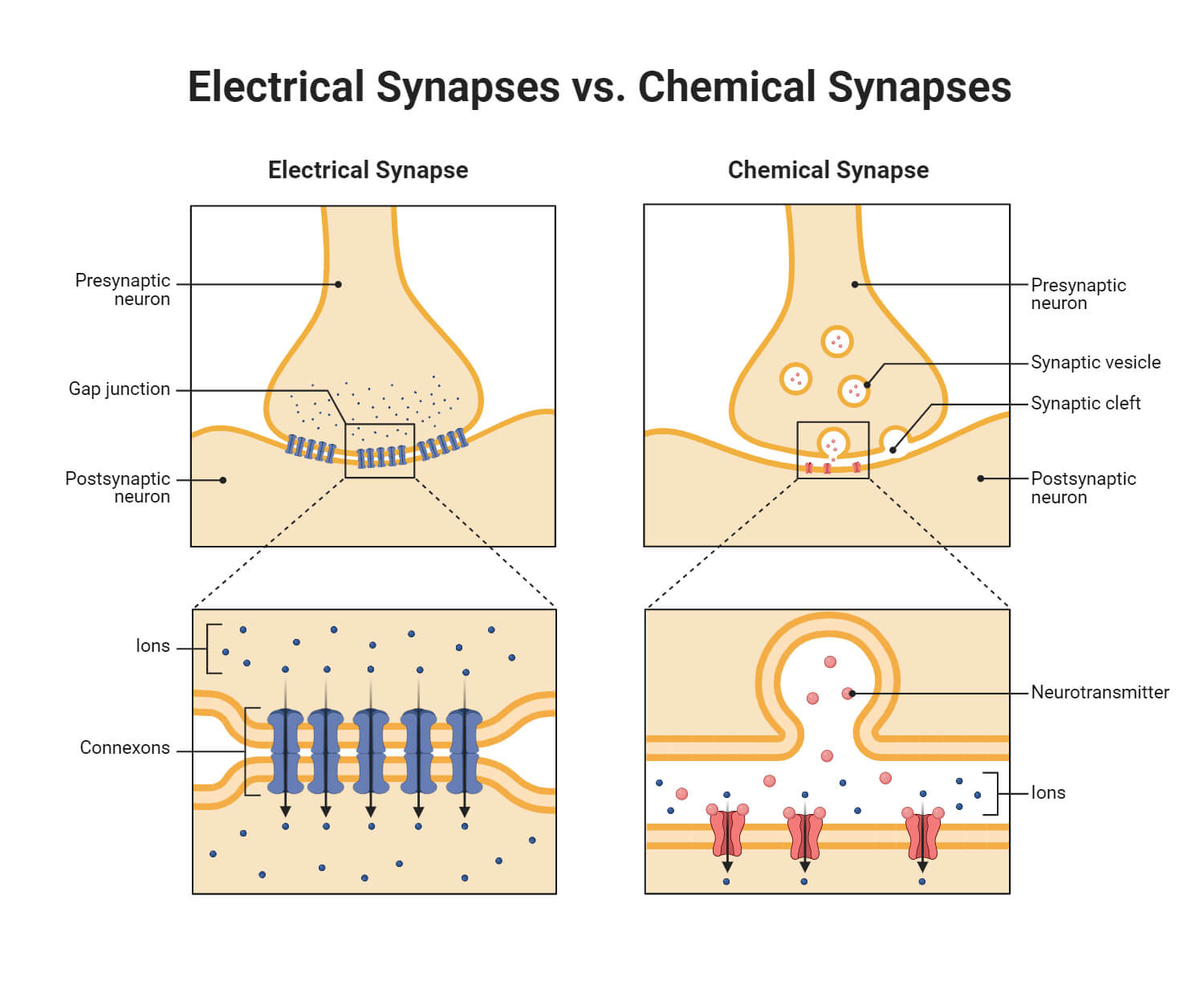
Functions of the Nerve Cells
- Nerve cells receive and transmit information in the form of electrical signals throughout the body. This allows communication within the nervous system which is vital for different body functions.
- Sensory neurons receive stimuli from the external environment. These nerve cells detect changes in the surroundings and transmit these signals to the central nervous system. This allows us to respond to our surroundings.
- Motor neurons receive signals from the brain and transmit these signals to muscles. They control muscle movements and allow voluntary movements like walking and running.
- Interneurons act as mediators and transmit signals between other neurons.
- Nerve cells are also involved in maintaining the concentrations of ions inside and outside their membranes which is important for generating and transmitting nerve impulses.
Diseases and Disorders of the Nerve Cells
Neurodegenerative disorders include several diseases that lead to progressive damage of nerve cells. These diseases are closely linked to aging. Neurodegenerative diseases are currently incurable. However, treatments focus on managing symptoms and improving quality of life. Some of the common neurodegenerative diseases are:
- Alzheimer’s disease is a neurodegenerative disease that leads to a gradual decline in memory and other cognitive abilities. As Alzheimer’s disease progresses, individuals may experience problems with communication, decision-making, and completing everyday tasks.
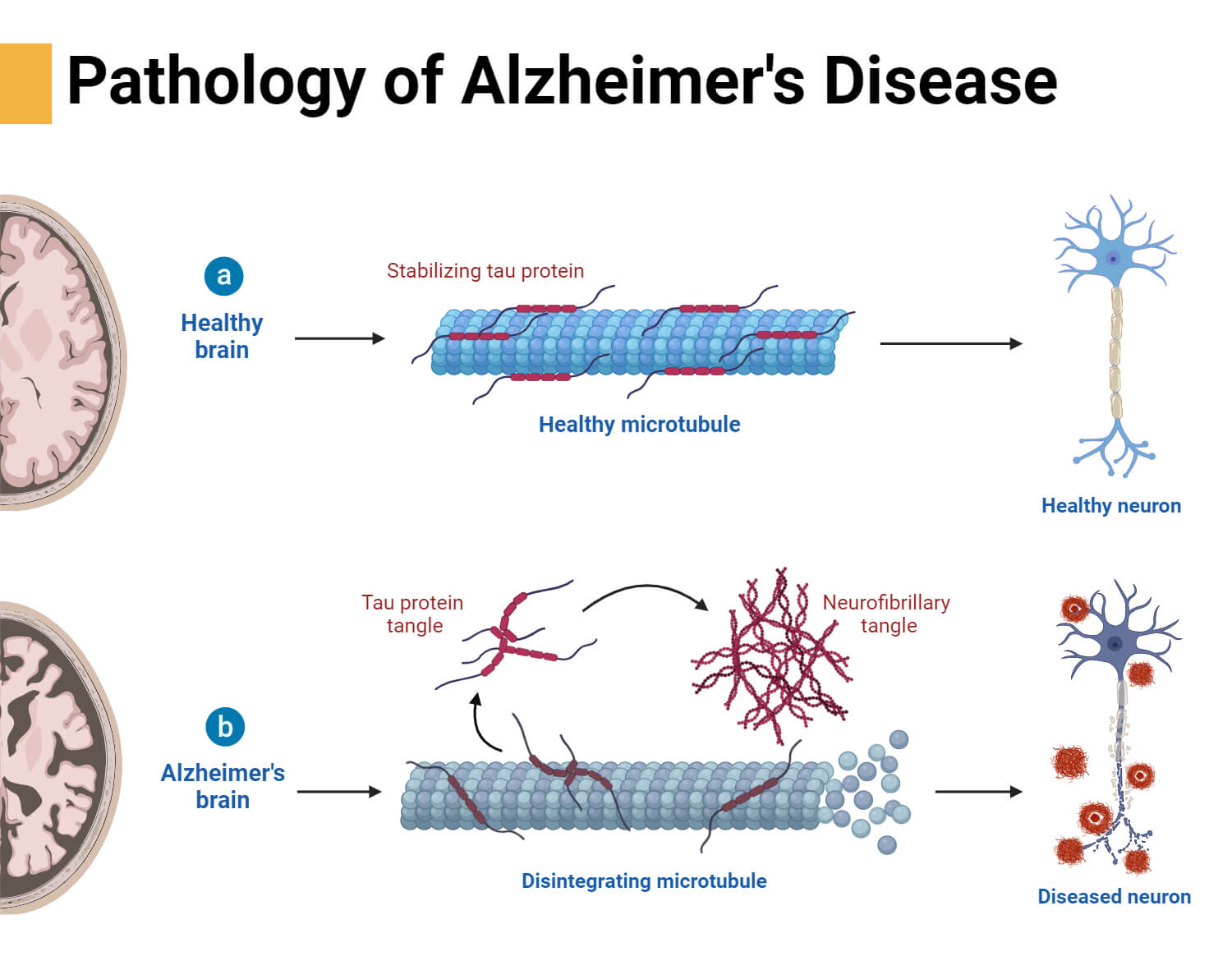
- Parkinson’s disease is a neurological disorder characterized by difficulties in movement. Over time, it also causes a decline in cognitive function. Symptoms include tremors, muscle stiffness, and impaired balance. Both genetic and non-genetic factors lead to the development of this disease, with age being the main risk factor.
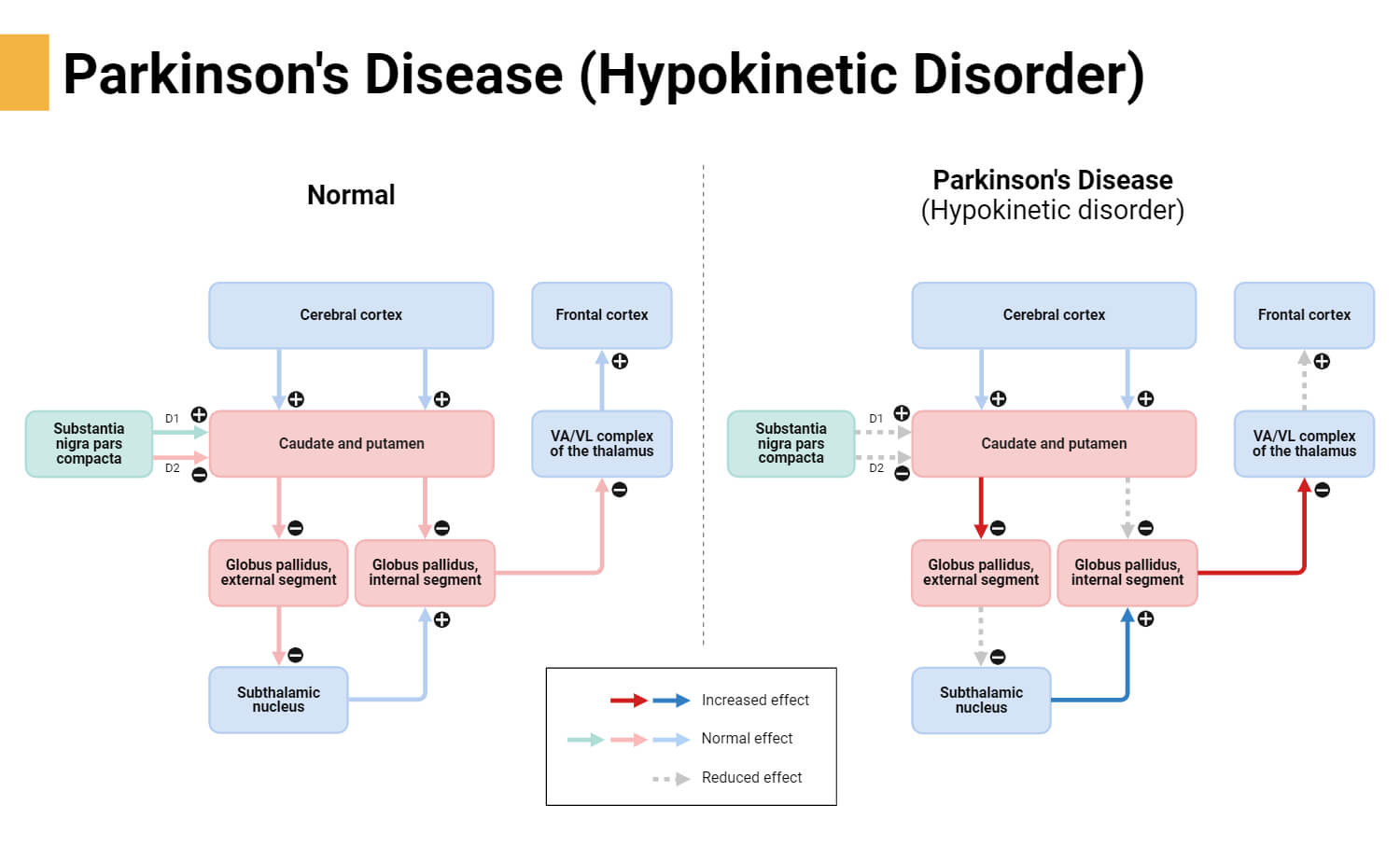
- Huntington’s disease is a genetic disorder that involves the gradual loss of nerve cells. This disease affects parts of the brain that control voluntary movement. Common symptoms include involuntary movements (chorea), unusual body postures, and problems with cognitive functions.

- Motor neuron diseases cause the degeneration of motor neurons that control movement. This results in muscle weakness and eventually paralysis. This includes several diseases, including amyotrophic lateral sclerosis (ALS), primary lateral sclerosis, progressive muscular atrophy, spinal muscular atrophy, and post-polio syndrome. Symptoms may also include breathlessness, chest infections, and disturbed sleep.
Peripheral neuropathy is a nerve cell disease that affects the peripheral nerves. Various factors can lead to this condition, such as diabetes, alcohol abuse, infections, autoimmune diseases, genetic disorders, and vascular disorders. Symptoms can include muscle weakness, uncontrolled muscle movements, numbness, imbalance, changes in blood pressure, and bowel problems. Treatment options include medications such as antidepressants, anticonvulsants, and pain relievers along with surgery in case of severe nerve injuries. Physical therapy and devices like braces and walkers can help with mobility.
Demyelinating diseases are conditions that damage the myelin sheath surrounding the nerve cells. Some of the common demyelinating diseases include multiple sclerosis (MS), transverse myelitis (TM), Guillain-Barré syndrome (GBS), Charcot-Marie-Tooth disease (CMT), and chronic inflammatory demyelinating polyneuropathy (CIDP). Symptoms include vision changes, tingling, muscle weakness, and difficulty walking. This disease is caused by immune system attacks on healthy myelin, viral or bacterial infections, genetic factors, and other medical conditions. Treatment options include medications and physical therapy.
References
- Ashley K, Lui F. Physiology, Nerve. [Updated 2023 May 1]. In: StatPearls [Internet]. Treasure Island (FL): StatPearls Publishing; 2024 Jan-. Available from: https://www.ncbi.nlm.nih.gov/books/NBK551652/
- BioExplorer.net. (2024, March 11). Explore Different Types of Nerve Cells. Bio Explorer. https://www.bioexplorer.net/nerve-cell-types.html/.
- Britannica, T. Editors of Encyclopaedia (2024, February 13). neuron. Encyclopedia Britannica. https://www.britannica.com/science/neuron
- Demyelinating Disease: What It Is, Symptoms & Treatment (clevelandclinic.org)
- Lamptey, R. N. L., Chaulagain, B., Trivedi, R., Gothwal, A., Layek, B., & Singh, J. (2022). A Review of the Common Neurodegenerative Disorders: Current Therapeutic Approaches and the Potential Role of Nanotherapeutics. International journal of molecular sciences, 23(3), 1851. https://doi.org/10.3390/ijms23031851
- Muzio MR, Cascella M. Histology, Axon. [Updated 2022 Nov 14]. In: StatPearls [Internet]. Treasure Island (FL): StatPearls Publishing; 2024 Jan-. Available from: https://www.ncbi.nlm.nih.gov/books/NBK554388/
- Nerve Cell Body | Complete Anatomy (elsevier.com)
- Nervous System Diseases: Types, Causes, Examples (healthline.com)
- Neurodegenerative Diseases: Definition, Symptoms, Causes, Treatment (verywellmind.com)
- Parts of a neuron: Structure and functions | Kenhub
- Peripheral Neuropathy | National Institute of Neurological Disorders and Stroke (nih.gov)
- Pryse-Phillips, W. E.M. (2023, June 22). nervous system disease. Encyclopedia Britannica. https://www.britannica.com/science/human-nervous-system-disease
- Purves D, Augustine GJ, Fitzpatrick D, et al., editors. Neuroscience. 2nd edition. Sunderland (MA): Sinauer Associates; 2001. Nerve Cells. Available from: https://www.ncbi.nlm.nih.gov/books/NBK11103/
